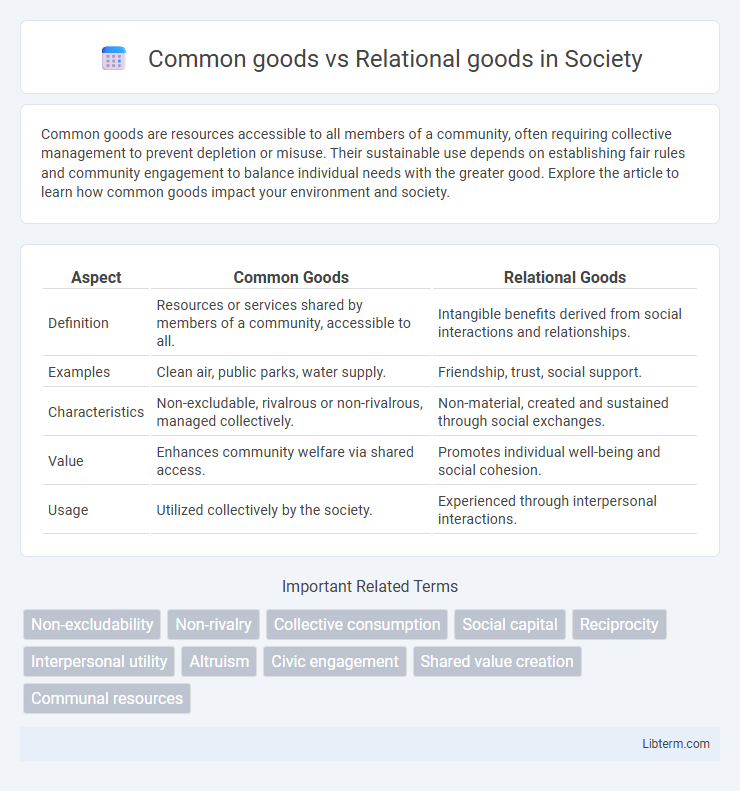Common goods are resources accessible to all members of a community, often requiring collective management to prevent depletion or misuse. Their sustainable use depends on establishing fair rules and community engagement to balance individual needs with the greater good. Explore the article to learn how common goods impact your environment and society.
Table of Comparison
| Aspect | Common Goods | Relational Goods |
|---|---|---|
| Definition | Resources or services shared by members of a community, accessible to all. | Intangible benefits derived from social interactions and relationships. |
| Examples | Clean air, public parks, water supply. | Friendship, trust, social support. |
| Characteristics | Non-excludable, rivalrous or non-rivalrous, managed collectively. | Non-material, created and sustained through social exchanges. |
| Value | Enhances community welfare via shared access. | Promotes individual well-being and social cohesion. |
| Usage | Utilized collectively by the society. | Experienced through interpersonal interactions. |
Understanding Common Goods: Definition and Examples
Common goods refer to resources or assets that are accessible to all members of a community but are rivalrous, meaning their consumption by one individual can reduce availability for others; typical examples include clean air, public parks, and fisheries. These goods require effective management and collective action to prevent overuse and depletion, a challenge often described as the "tragedy of the commons." Understanding common goods entails recognizing their shared nature and the importance of sustainable policies to balance individual use with long-term preservation for communal benefit.
What Are Relational Goods? Key Concepts Explained
Relational goods are intangible assets derived from social interactions and relationships, such as trust, friendship, and cooperation, which enhance individual well-being and community cohesion. Unlike common goods, which are physical resources accessible to all, relational goods depend on active participation and mutual engagement among people. These goods contribute to social capital and are essential for fostering collaboration and emotional support within societies.
Differences Between Common Goods and Relational Goods
Common goods are resources available to all members of a community, such as clean air or public parks, characterized by their non-excludability and rivalrous consumption. Relational goods, however, arise from social interactions and relationships, including trust, friendship, and cooperation, and are inherently non-material and non-excludable. The primary difference lies in common goods being tangible resources shared physically, whereas relational goods represent intangible benefits derived from social connections.
Economic Perspectives on Common and Relational Goods
Economic perspectives distinguish common goods as rivalrous and non-excludable resources like fisheries and public parks, often subject to overuse without proper management. Relational goods encompass social interactions and networks that generate mutual benefits and trust, enhancing social capital and overall well-being. Policy approaches emphasize sustainable management of common goods through collective action, while fostering relational goods by promoting community engagement and social cohesion.
Social Impact of Common Goods in Communities
Common goods, such as public parks and clean air, foster community well-being by providing shared resources that support collective health and social cohesion. These goods enhance social impact by enabling equitable access to essential services and spaces, reducing inequalities and promoting a sense of belonging among community members. Unlike relational goods, which arise from interpersonal interactions, common goods create the foundation for sustainable community development and inclusive social environments.
The Role of Relational Goods in Human Well-Being
Relational goods, such as social connections, trust, and shared experiences, play a crucial role in human well-being by fostering emotional support, enhancing mental health, and promoting a sense of belonging. Unlike common goods, which are tangible and non-excludable resources like clean air or public parks, relational goods are intangible and arise from interpersonal interactions that increase overall life satisfaction. Studies in social psychology confirm that strong relational goods contribute to lower stress levels and greater happiness, highlighting their indispensable role in holistic well-being.
Challenges in Managing Common Goods
Managing common goods faces challenges such as overuse and depletion, known as the tragedy of the commons, where individuals acting in self-interest reduce shared resources. Ensuring equitable access and sustainable maintenance requires effective governance, monitoring, and community cooperation. Conflicts often arise due to unclear property rights and difficulties in enforcing regulations across diverse stakeholders.
Fostering Relational Goods in Modern Society
Fostering relational goods in modern society involves prioritizing social connections, trust, and shared experiences that contribute to community well-being beyond material wealth. Policies encouraging community engagement, cooperation, and inclusive social networks enhance relational goods by promoting mutual support and collective identity. Investing in public spaces, social programs, and communication platforms strengthens these bonds, creating resilient societies characterized by high social capital and interpersonal trust.
Policy Approaches: Supporting Common and Relational Goods
Policy approaches supporting common goods emphasize sustainable resource management, equitable access, and community involvement to preserve shared assets like clean air, public parks, and fisheries. In contrast, policies fostering relational goods prioritize social networks, trust-building initiatives, and cooperative frameworks that enhance interpersonal connections and community well-being. Integrating strategies that balance ecological stewardship with social cohesion creates resilient societies benefiting both environmental sustainability and collective social capital.
Future Trends: The Evolving Value of Goods in Society
Common goods, characterized by shared accessibility and collective benefit, will face increased emphasis on sustainability and digital management through blockchain technologies to ensure equitable distribution and preservation. Relational goods, deriving value from interpersonal interactions and social connections, will gain prominence in a digitally fragmented society as virtual communities and social platforms foster new forms of meaningful engagement. Future trends indicate a blending of these goods, where digital commons support relational networks, reshaping societal value systems towards collaborative consumption and enhanced social capital.
Common goods Infographic

 libterm.com
libterm.com